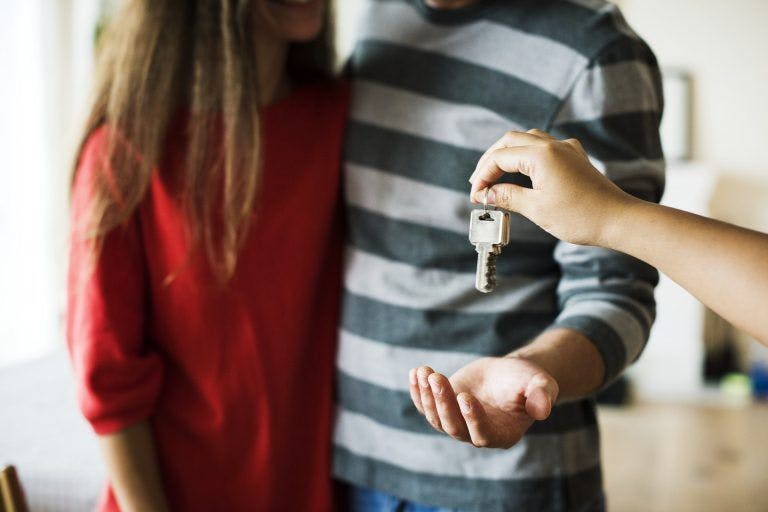
How to buy your first home: Bamboo’s 5 step guide

Figuring out how to buy your first home can be tricky, but it’s not impossible. In 2017, tenants paid a whopping £51.6 billion in rent to private landlords. Of that, millennials paid 59% of the total rent, which came in at just over £30 billion. How do you save up for a deposit when a large portion of your income goes on rent and bills? Here are five steps you can take to get yourself on the property ladder.
Step #1: Start budgeting as early as possible
We won’t sugar-coat it: saving up for a deposit on a mortgage isn’t easy. Although you can get a mortgage with 5% of the property value, it’s much more realistic to aim for saving a 10% deposit. But the saving is a lot easier if you get started as early as possible. Getting into a good money-saving habits and giving yourself longer to save is going to substantially improve your chances of gathering up a deposit and demonstrate to the lender that you’re responsible with money. We’re not going into the ins-and-outs of saving and budgeting here, but we’ve written a whole host of posts before about saving and budgeting that might be handy if you’re wondering how to buy your first home. Take a look at these articles on stress-free money management and using a budget planner.
Step #2: Use the schemes and funding sources available to you
There are a few different schemes that can help you work out how to buy your first home.
Help to Buy: A government scheme available to first-time buyers and existing homeowners who want to buy a new build. You can borrow up to 20% of the property price interest-free for the first five years. You need to have at least a 5% deposit. However, with Help to Buy, there are limits on the cost of the property you can buy. The Money Advice Service have a great guide on Help to Buy.
Right to Buy: The Right to Buy scheme lets tenants from England, Wales and Northern Ireland who rent their home from their local council to buy their home at a discounted rate. If you’ve rented from the council for 3 years or more, you might qualify to buy your house.
Shared Ownership: An unusual, out-of-the-box option for home-ownership, shared ownership is when you buy a share of a home from the landlord and then rent the remaining percentage of the house. You need a mortgage for your share, which can be for anywhere between 25% and 75% of the house’s value. At a later date, you can extend your mortgage or buy the rest of the property to own 100% of it
Step #3: Don’t forget to budget for the other costs associated with buying a house
In addition to the deposit, there are lots of other costs that crop up when you’re buying your first home. Here are a few of the unavoidable ones:
- Survey costs (about £400 on average)
- Solicitor’s fee (usually between £850 and £1,500)
- Removal costs (£300-£600, although you can keep costs down by DIY-ing it.)
- Estate agent’s fee (usually between 1% to 3% of the sale price plus 20% VAT)
- Mortgage and valuation fees (usually £2,000+)
- Stamp Duty (you don’t pay Stamp Duty on the first £300,000 for properties worth up to £500,000, but after that, you have to pay a percentage of the property price. Money Advice Service have a handy calculator for this.)
Make sure you’ve factored these into your house-buying budget before you pull the trigger! Noe:Facts and figures all taken from Money Advice Service.
Step #4: Budget for after you’ve bought your first home
When you’re working out how to buy your first home, you’re probably focusing on everything up to the moment you get the keys in your hand and open your door for the first time. However, the banks and mortgage lenders think beyond that point, so it’s a good idea to prepare for after you’ve completed too. As a first-time home buyer, the single most important thing to consider is whether you can afford the mortgage repayments. Not only will it help you avoid any sticky situations, but it’ll help you sail through the strict affordability checks that lenders do before you’re approved for a mortgage.
Side note: lenders also ‘stress test’ your income and savings to make sure you can afford the mortgage if you lose a job, fall ill or have a child. Make sure you have everything on hand to show them, including:
- Evidence of debts and outgoings (household bills, subscriptions, etc.)
- Evidence of other costs (clothing, childcare and travel, etc.)
- Proof of income (payslips and bank statements if you’re employed, tax returns from the past two years if you are self-employed)
Step #5: If you’re struggling to save a deposit, explore any other options
Sometimes, no matter how much you save, life gets in the way and you can’t get a deposit together. If that happens, don’t give up. There are still ways to work out how to buy your first home and a guarantor mortgage is one of those options.
Just like guarantor loans, a guarantor mortgage works off the principle that having somebody guarantee your mortgage makes you a more appealing candidate. In other words, if a parent, guardian or close relative agrees to be responsible for paying the mortgage, you may still be eligible for a mortgage with a relatively small deposit.
So there you have it, our 5 steps you can take towards buying your first home!
Author
The Bamboo Team
Posted
06 March 2019